North Horn Formation facts for kids
Quick facts for kids North Horn FormationStratigraphic range: Maastrichtian-Danian ~71–64Ma |
|
|---|---|
| Type | Geological formation |
| Underlies | Flagstaff Formation |
| Overlies | Price River & Tuscher Formations |
| Thickness | >1,100 m (3,600 ft) |
| Lithology | |
| Primary | Sandstone, shale, conglomerate |
| Other | Siltstone, limestone, coal |
| Location | |
| Coordinates | 39°00′N 111°00′W / 39.0°N 111.0°W |
| Approximate paleocoordinates | 46°48′N 88°00′W / 46.8°N 88.0°W |
| Region | Utah |
| Country | |
| Extent | ~140 km (87 mi) |
| Type section | |
| Named for | North Horn Mountain |
The North Horn Formation is a large area of rock layers found in central and eastern Utah, USA. These rocks formed on land, not in the ocean. You can see these rock layers in many places. They can be over 1,100 m (3,600 ft) (about 3,600 feet) thick.
These rocks were laid down by ancient rivers, lakes, and floodplains. This means it was a busy place on land where a lot of sand, mud, and pebbles were deposited. The rocks date from the very end of the Cretaceous Period (about 71 million years ago) to the early Paleocene Epoch (about 64 million years ago).
The North Horn Formation includes the time when the dinosaurs disappeared, known as the K-Pg extinction event. It's hard to find the exact spot where this happened in these rocks. There isn't a special clay layer, like in some other places, to mark it. Instead, scientists see a big change in the fossils. Before the K-Pg event, there were many dinosaur fossils. After it, mammal fossils became much more common.
Fossils found in the Cretaceous part of the formation include ancient lizards and snakes, turtles, crocodile-like reptiles, sharks, bony fish, amphibians, early mammals, and dinosaurs. Scientists have also found dinosaur eggshell pieces, fossilized tracks, shells, and tiny plant spores and pollen.
Contents
Rock Layers and Location
The North Horn Formation is made of rock layers that formed on land. It is found in eastern and central Utah. These layers sit on top of older rocks called the Price River Formation and the Tuscher Formation. Above the North Horn Formation, you'll find the Flagstaff Formation.
The main place where scientists first studied the North Horn Formation is on North Horn Mountain in Emery County, Utah. The formation stretches for about 140 km (87 mi) (about 87 miles) from the Wasatch Plateau in the west to the Book Cliffs in the east. The San Rafael Swell, a large dome-shaped uplift, sits in the middle of this area.
The North Horn Formation changes a lot in how thick it is and what types of rocks it contains. This means that the age of the bottom and top of the rock layers changes as you move across the area. For example, in the west, the bottom of the North Horn Formation is from the very end of the Cretaceous Period. But in the east, the bottom layers are from the Paleocene Epoch, which is younger.
The thickest parts of the North Horn Formation are found west of the San Rafael Swell. Here, the layers can be over 1,100 m (3,600 ft) (3,600 feet) thick. As you move east, towards Green River, the rock layers become much thinner, sometimes only 15 to 40 m (49 to 131 ft) (50 to 130 feet) thick.
Types of Rocks
Scientists divide the North Horn Formation into three main parts based on the types of rocks. These are:
- A lower part with many different colored rocks.
- A middle part that contains coal (where the K-Pg boundary is found).
- An upper part, also with many different colored rocks.
These main parts are further divided into smaller units based on specific rock features. For example, the very bottom of the formation often has a thick layer of conglomerate (rocks made of rounded pebbles and cobbles) and sandstone. Above that are layers of red sandy siltstone, conglomerate, and pebbly sandstone.
Higher up, you find layers of sandstone mixed with gray and dark siltstones. Some limestone beds are also present but are not common. The coal-bearing unit is known for its thick coal beds and siltstone with streaks of coal. Above this, there are layers of siltstone rich in calcium carbonate. The upper parts of the formation include more conglomerate and sandstone, and finally, a thick layer of red-brown siltstone.
Ancient Life (Paleontology)
The North Horn Formation is famous for its fossils, especially from the time when dinosaurs lived and right after they disappeared.
Dinosaurs and Other Cretaceous Animals
In the Cretaceous layers of the North Horn Formation, scientists have found fossils of several well-known dinosaurs:
- The horned dinosaur Torosaurus utahensis
- The long-necked sauropod Alamosaurus sanjuanensis
- The fearsome meat-eater Tyrannosaurus
However, the most common fossil found from the Cretaceous part of the formation is a lizard-like reptile called Polyglyphanodon.
Scientists have also found tracks of flying reptiles called pterodactyloids at one site. These tracks are kept at the Dinosaur Tracks Museum at the University of Colorado at Denver. Bird and dinosaur eggs have also been discovered, along with fossils of duck-billed dinosaurs (hadrosaurs), possibly Edmontosaurus or Kritosaurus.
Paleocene Animals
After the K-Pg extinction event, the fossils in the North Horn Formation change a lot. The Paleocene layers show a much wider variety of animals, with over 70 different types identified. These include:
- Frogs
- Many different types of early mammals, such as multituberculates, protoeutherians, periptychids, arctocyonids, and phenacodontids.
- Crocodile-like reptiles
- Choristoderes (another type of ancient reptile)
- Fossilized tracks
- Tiny plant spores and pollen
Fossils of early Marsupials, similar to Alphadon and Eodelphis, have also been found here.
Fossil Content
Color key
|
Notes Uncertain or tentative taxa are in small text; |
| Genus | Species | Location | Stratigraphic position | Abundance | Notes | Image |
|---|---|---|---|---|---|---|
| Adocus | A. sp | 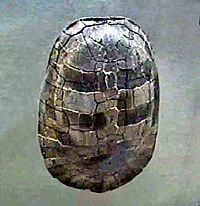 |
||||
| Alamosaurus | A. sanjuanensis | 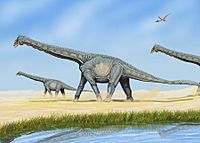 |
||||
| Basilemys | B. sp | 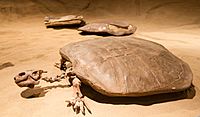 |
||||
| Champsosaurus | C. sp | 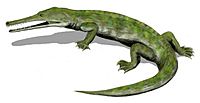 |
||||
| Lepisosteus | L. sp. |  |
||||
| Polyglyphanodon | P. sternbergi | 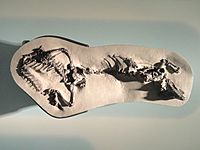 |
||||
| Pteraichnus | Found at an unnamed site. | Specimens kept at the Dinosaur Tracks Museum, of the University of Colorado at Denver. | ||||
| Torosaurus | T. utahensis |  |
||||
| Tyrannosaurus | T. sp. |  |


